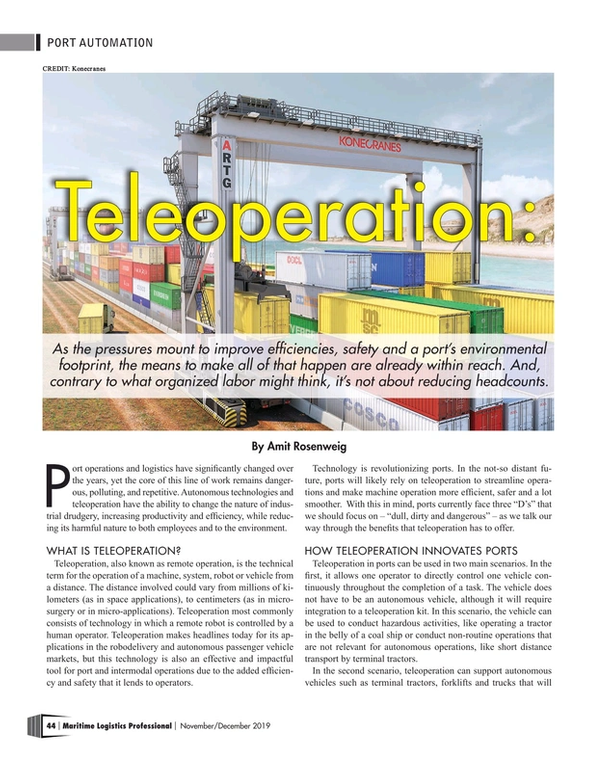
Teleoperation: Set to Revolutionize Intermodal Operations
As the pressures mount to improve efficiencies, safety and a port’s environmental footprint, the means to make all of that happen are already within reach. And, contrary to what organized labor might think, it’s not about reducing headcounts.
Port operations and logistics have significantly changed over the years, yet the core of this line of work remains dangerous, polluting, and repetitive. Autonomous technologies and teleoperation have the ability to change the nature of industrial drudgery, increasing productivity and efficiency, while reducing its harmful nature to both employees and to the environment.
What is teleoperation?
Teleoperation, also known as remote operation, is the technical term for the operation of a machine, system, robot or vehicle from a distance. The distance involved could vary from millions of kilometers (as in space applications), to centimeters (as in microsurgery or in micro-applications). Teleoperation most commonly consists of technology in which a remote robot is controlled by a human operator. Teleoperation makes headlines today for its applications in the robodelivery and autonomous passenger vehicle markets, but this technology is also an effective and impactful tool for port and intermodal operations due to the added efficiency and safety that it lends to operators.
Technology is revolutionizing ports. In the not-so distant future, ports will likely rely on teleoperation to streamline operations and make machine operation more efficient, safer and a lot smoother. With this in mind, ports currently face three “D’s” that we should focus on – “dull, dirty and dangerous” – as we talk our way through the benefits that teleoperation has to offer.
How teleoperation innovates ports
Teleoperation in ports can be used in two main scenarios. In the first, it allows one operator to directly control one vehicle continuously throughout the completion of a task. The vehicle does not have to be an autonomous vehicle, although it will require integration to a teleoperation kit. In this scenario, the vehicle can be used to conduct hazardous activities, like operating a tractor in the belly of a coal ship or conduct non-routine operations that are not relevant for autonomous operations, like short distance transport by terminal tractors.
In the second scenario, teleoperation can support autonomous vehicles such as terminal tractors, forklifts and trucks that will mostly operate autonomously. Teleoperation will allow these vehicles to navigate edge cases that require human intervention for situations such as abnormal stops, lost self-positioning, incomplete jobs or changes to the operational environment. In this scenario, one operator can support several vehicles as they only require the human operator’s attention for a few moments at a time. Once the vehicles receive that help, they continue autonomously.
Although autonomous vehicle technology is advancing toward providing a complete solution to all logistics and port operation scenarios, for the foreseeable future, it’s easier and safer to have a human help operate these vehicles remotely using teleoperation technology.
The advantages of teleoperation go beyond economic efficiencies and safety as they can also contribute to reductions in emissions. Teleoperated vehicles require less energy and operate less hours – they don’t need to run the air conditioning/heating, and they do not need to transport a driver back and forth around the port, as their operators control the vehicles from the comfort of their office.
Teleoperation as a new career path
Teleoperation also provides port workers with new employment opportunities, and the potential to extend their skill set and advance their career. New technologies like teleoperation require additional training and certification. Training to operate teleoperated vehicles will open completely new positions for port employees.
Teleoperation will also improve the wellbeing and work conditions of operators who are currently exposed to potentially dangerous situations. With teleoperation, their job will be conducted in the safety and comfort of an office, away from the elements.
Some logistics employees are paid based on the efficiency of their work. Teleoperation provides these employees a new platform to improve their own efficiency and increase both their pay and company revenues. Recently, workers at the port of Los Angeles supported the use of autonomous operations onsite due to the efficiency gains and higher earning power it offered them.
 A typical example of a safe, secure and efficient remote controlled intermodal operations. (Image: Konecranes)
A typical example of a safe, secure and efficient remote controlled intermodal operations. (Image: Konecranes)
Teleoperation decreases costs and pollution
The globalization of trade makes the shipment of goods via maritime transport a fundamental sector of the world economy. Currently, over 80 percent of all world trade is carried by sea. Overall, 25 percent of world energy consumption is employed for transport. About 75 percent of this energy is employed for road transport, 12 percent for shipping and 12 percent for air transport.
Clearly the intermodal industry is under pressure to reduce energy consumption and emissions. As the majority of trucks, terminal tractors, and forklifts used today are diesel powered, any operational improvement can lead to substantial reduction in energy consumption and emissions. Teleoperation can do just that. For example, by using a teleoperated terminal tractors can help reduce dwell time for trucks waiting to pick up or unload their cargo at port entrances. Once dwell time is reduced, drivers will no longer need to wait in their cabins and run their engines for heating or air conditioning.
The industry is also facing a shortage of skilled operators and an increase in labor costs. Once again; teleoperation provides a solution – relying upon fewer workers to remotely oversee and support the operation of a fleet of autonomous vehicles. Even when used in a direct mode of operation with one operator directly controlling one vehicle, that operator can be reassigned immediately to operate another vehicle at the other end of the port – at the click of a button. This provides operational efficiencies and substantial cost reductions. Moreover, while these vehicles are not operating, their engines can be remotely shut down, reducing energy consumption.
The chances of injury/death is minimized with teleoperation
Teleoperation can help remove humans from dangerous situations in port operations. Between 2011 and 2016, port workers were subject to fatal injuries at a rate five times higher than the overall U.S. workforce. The risk of injury or death is minimized with the use of teleoperation as fewer people are working in the danger zone.
Bottom Line – a faster, cleaner and safer one
While teleoperation is a newer innovation within shipping, logistics and related industries, it is becoming increasingly clear that it has the ability to make a significant impact at ports worldwide. Expect more port workers to soon encounter first-hand the safer, cleaner and more efficient outcomes of integrating teleoperation into their daily routines.
 Amit Rosenzweig is CEO and founder of Ottopia, a company that provides teleoperation technology for any vehicle. He enjoys marrying technology with customer needs, and has been doing so over the last 12 years. |
Read Teleoperation: Set to Revolutionize Intermodal Operations in Pdf, Flash or Html5 edition of Nov/Dec 2019 Maritime Logistics Professional


